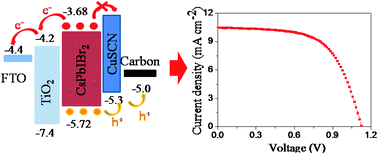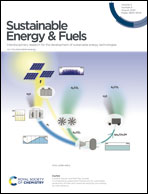A multifunctional CuSCN interlayer in carbon electrode-based CsPbIBr2 all-inorganic perovskite solar cells for boosting the efficiency and stability†
Abstract
Carbon electrode-based all-inorganic perovskite solar cells (PSCs) without hole-transport materials are attracting extensive interest due to their low cost, simple fabrication process, and high stability. Nevertheless, the conversion efficiency of carbon electrode-based PSCs is far from satisfactory owing to serious charge recombination at the inorganic perovskite/carbon interface, which mainly derives from the mismatched energy level between the inorganic perovskite film and carbon layer. Herein, a hydrophobic CuSCN film is introduced into carbon electrode-based CsPbIBr2 all-inorganic PSCs as a multifunctional interlayer between the CsPbIBr2 perovskite film and carbon electrode to form a favorable interfacial energy level alignment and protect the CsPbIBr2 perovskite from ambient moisture. It is found that introducing a CuSCN interlayer can not only enhance the hole extraction and suppress the charge recombination in carbon electrode-based CsPbIBr2 all-inorganic PSCs, but also improve the stability of the cell. Moreover, the very strong interaction between SCN−1 and Pb2+ remarkably reduces the surface defects of the CsPbIBr2 perovskite film. Consequently, the device with the CuSCN interlayer displays an improved power conversion efficiency of 7.30% in comparison with 5.19% for the device without the CuSCN interlayer and an excellent long-term stability under the ambient conditions.



 Please wait while we load your content...
Please wait while we load your content...